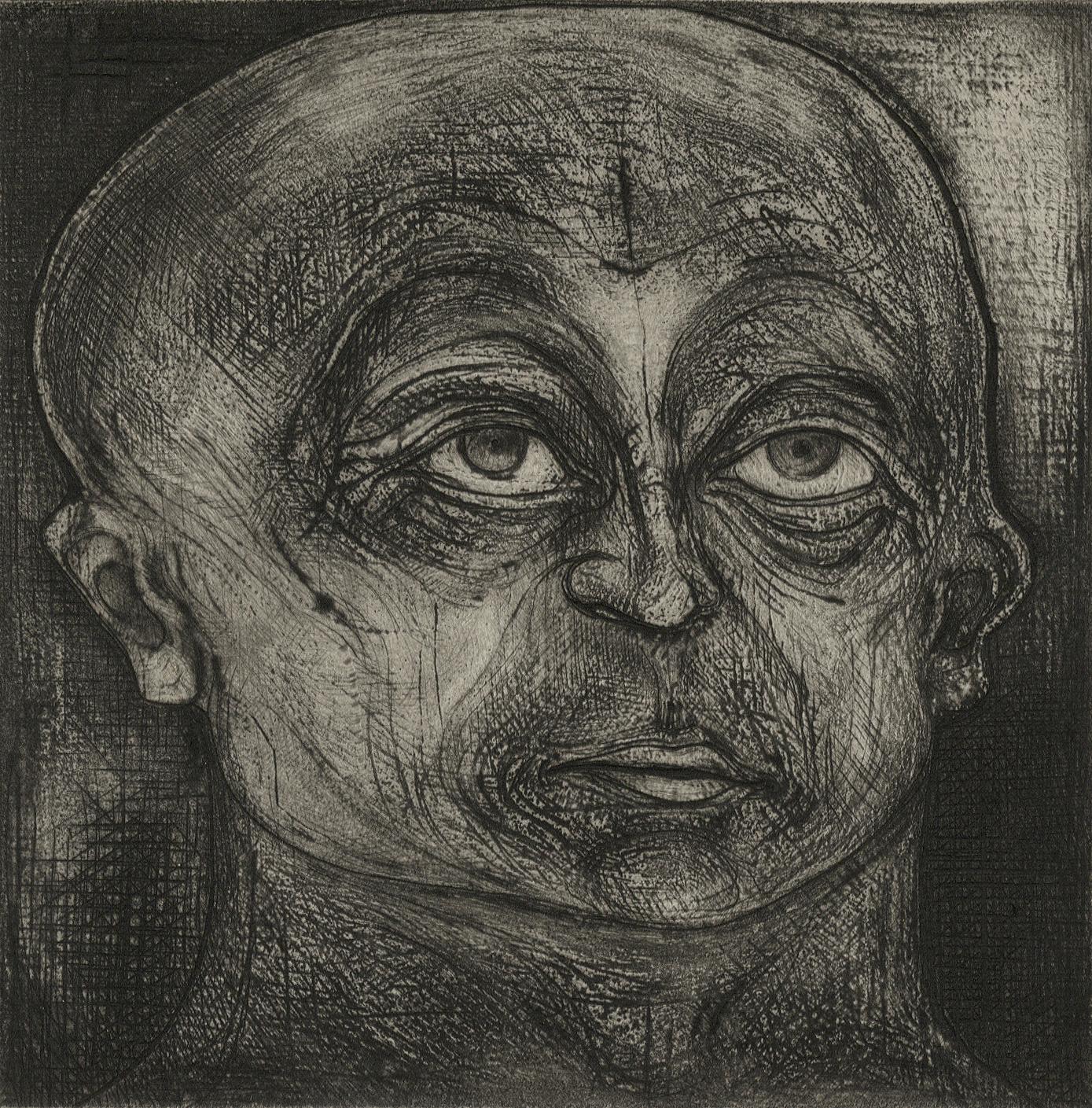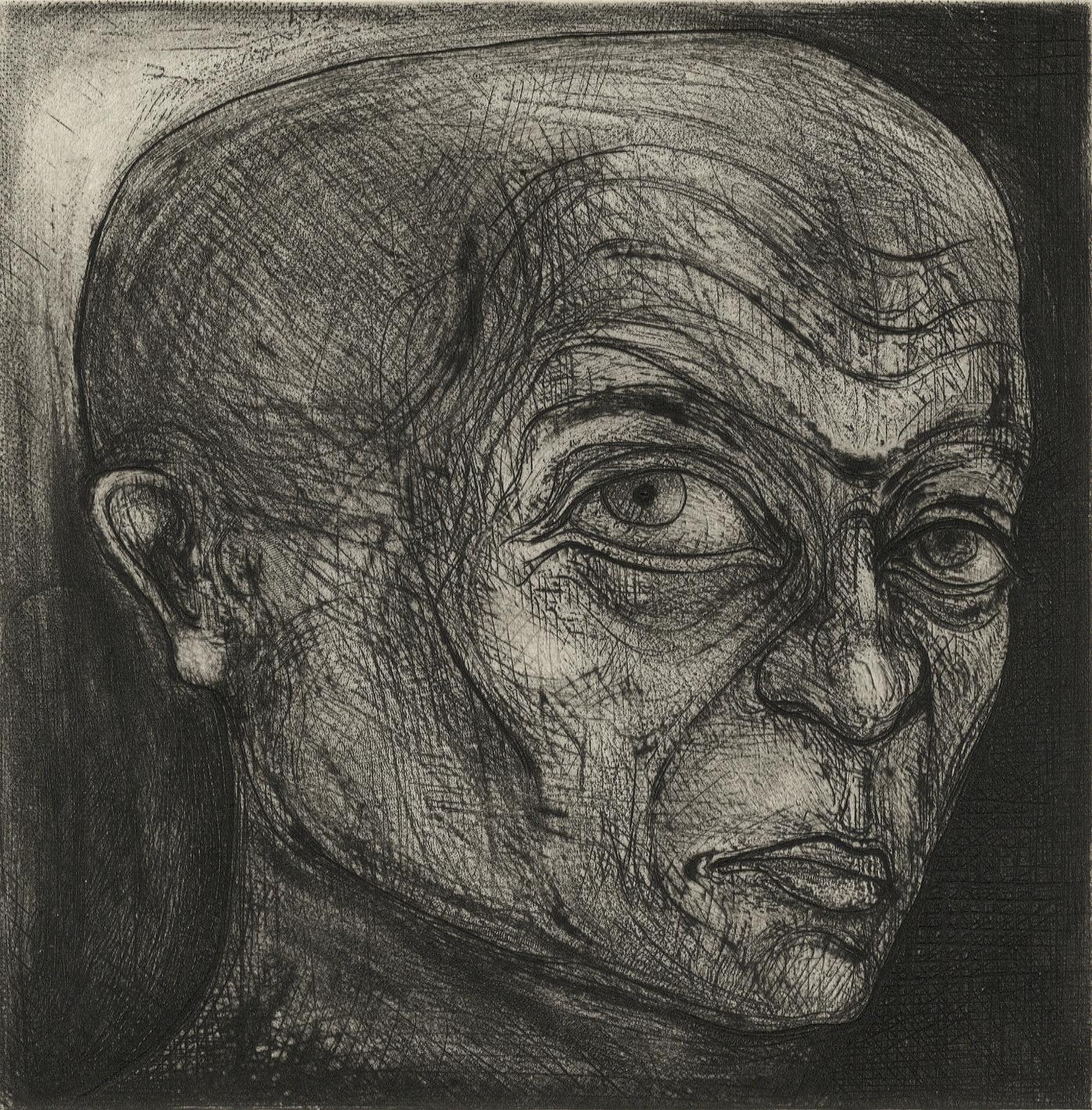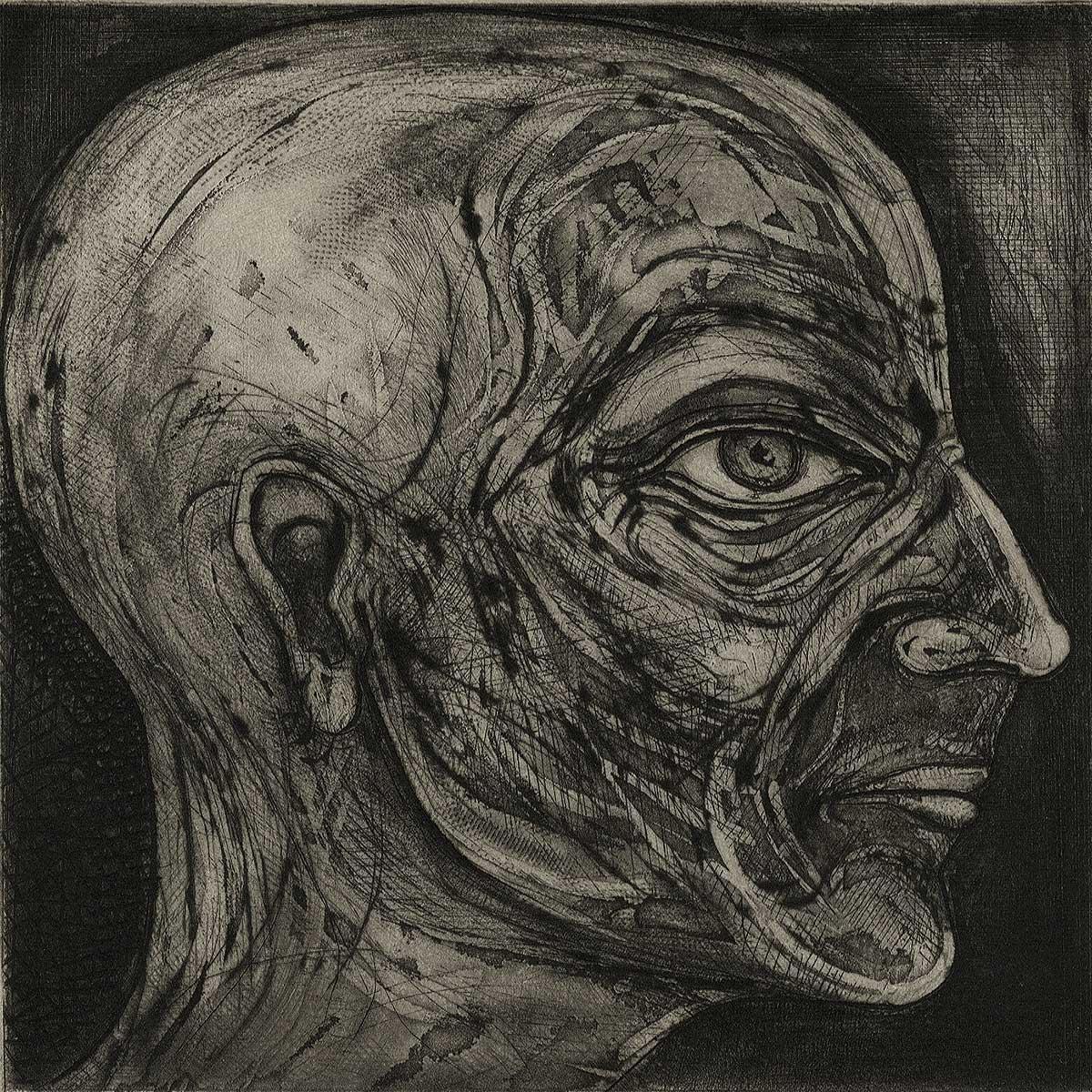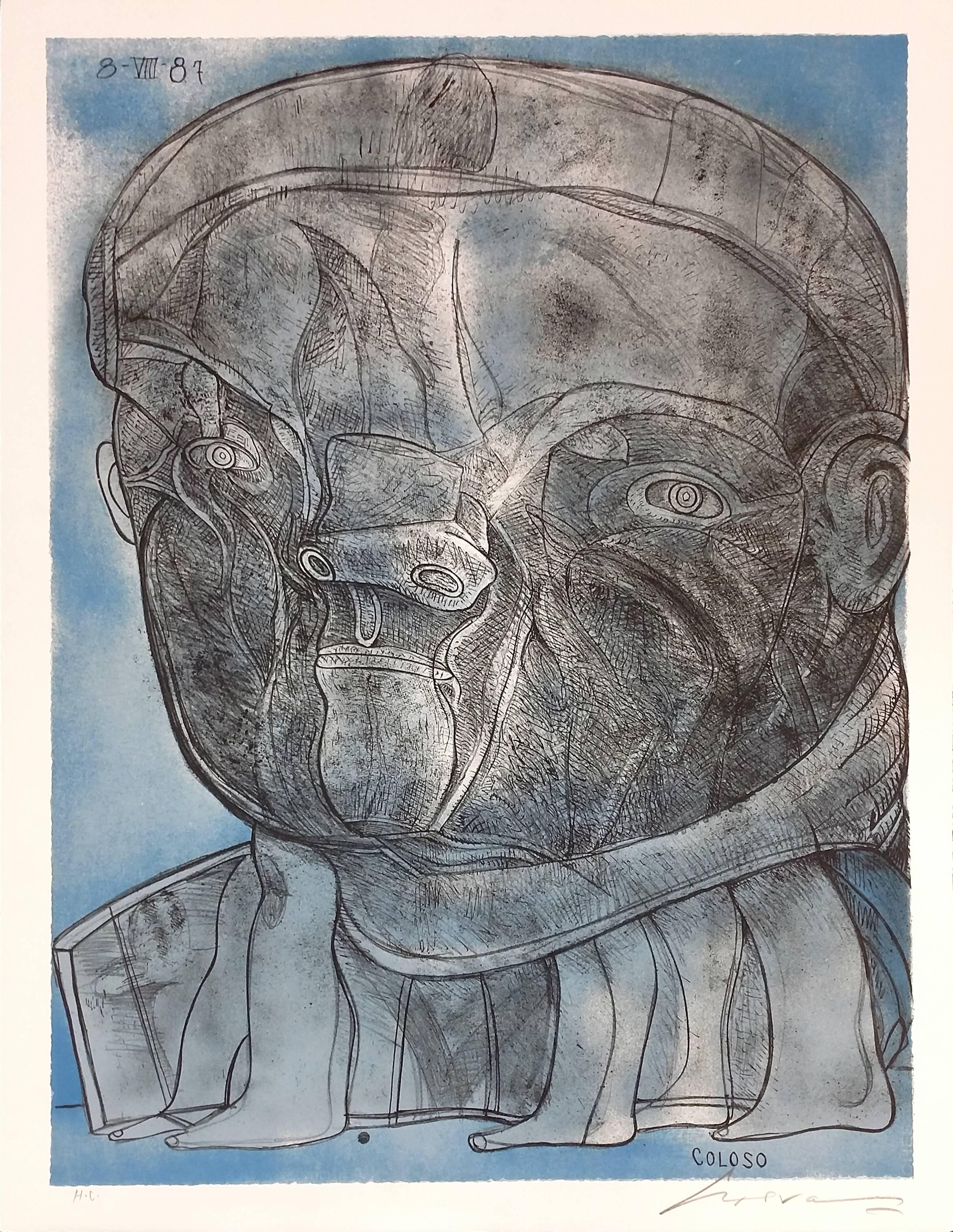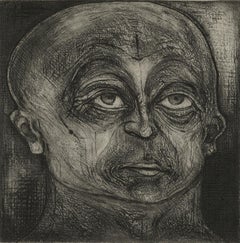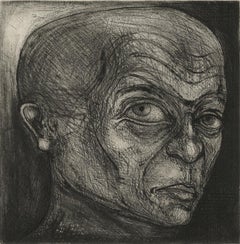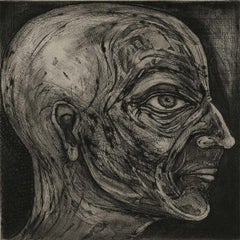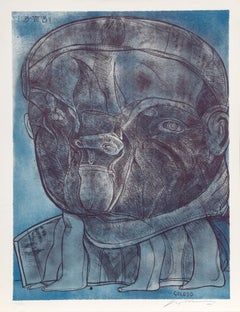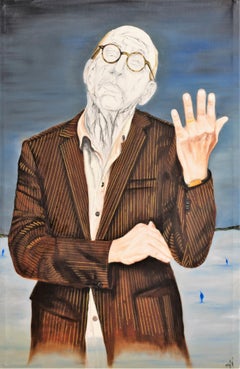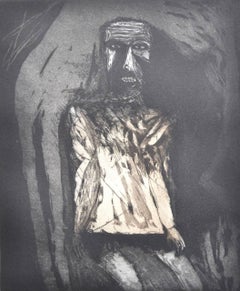Items Similar to Mr. Thirteen (the insignificance of the significant)
Want more images or videos?
Request additional images or videos from the seller
1 of 8
Seyed M. S. EdalatpourMr. Thirteen (the insignificance of the significant)1995
1995
$697
$1,20041% Off
£517.20
£890.4541% Off
€602.47
€1,037.2541% Off
CA$970.23
CA$1,670.4141% Off
A$1,080.44
A$1,860.1541% Off
CHF 562.31
CHF 968.1141% Off
MX$13,321.66
MX$22,935.4341% Off
NOK 7,161.42
NOK 12,329.5741% Off
SEK 6,731.04
SEK 11,588.6041% Off
DKK 4,495.16
DKK 7,739.1641% Off
Shipping
Retrieving quote...The 1stDibs Promise:
Authenticity Guarantee,
Money-Back Guarantee,
24-Hour Cancellation
About the Item
"Mr. Thirteen" is an etching, engraving and drypoint created in 1995, edition: 12 signed in pencil. The print has an embossed chop in the lower right corner, a capital P in a circle indicating that it was printed by Pratt Contemporary Art, Kent, England. This image was issued with a series of 12 small heads titled "One of Twelve". These intaglio prints are based on a sculpture featuring disembodied heads.
The Thirteenth creates a different proportional system and it is suggestive of the multitude, the plurality and the insignificance of the significant.
This is an installation of thirteen heads, twelve of which are identical in dimension and the thirteenth head is much larger. The installation is designed in accordance with geometrical rules. Twelve and the 13th began with twelve blocks of stone, identical in dimension. Within the square block exists a perfect sphere. The sphere, the desired sphere, it is the reflection of a point, a point with no dimension. The journey from one to twelve is an investigation into the desired Sphere. The possibilities of the form are investigated, the many faces of the sphere.
’O Lord how marvellous is Thy face
Thy face, which a young man, if he strove to imagine it, would conceive as a youth's; a full-grown man, as manly; an aged man as an aged man's! Who could imagine this sole pattern, most true and most adequate, of all faces - of all even as of each - this pattern so very perfectly of each as if it were of none other? He would have to go beyond all forms of faces, and all likenesses and all figures. And how could he imagine a face when he must go beyond all faces, and all likenesses and figures of all faces and all concepts which can be formed of a face, and all colour, adornment and beauty of all of all faces? Wherefore he that goeth forward to behold Thy face, so long as he formeth any concept, thereof, is far from Thy face. For all concept of a face falleth short, Lord, of Thy face, and all beauty which can be conceived is less than the beauty of Thy face; every face hath beauty yet none is beauty's self, but Thy face, Lord, hath beauty and this having is being. 'Tis therefore Absolute Beauty itself, which is the form that giveth being to every beautiful form. 0 face exceedingly comely, whose beauty all things to whom it is granted to behold it, suffice not to admire! In all faces is seen the Face of faces, veiled, and in a riddle; howbeit unveiled it is not seen, until above all faces a man enter into a certain secret and mystic silence where there is no knowledge or concept is the state below which Thy face entereth when he goeth beyond all knowledge or concept of a face. This mist, cloud, darkness, or ignorance into which he that seeketh Thy face 'entereth when he goeth beyond all knowledge or concept is the state below which Thy face cannot be found except veiled; but that very darkness revealeth Thy face there, beyond all veils.’²
Twelve is a number, perhaps of a significant value. Any given number is the smaller sum of its proceeding one. Twelve as significant as it may be, it is not more so than the thirteenth.
The shock of displacement was the driving force in Seyed Edalatpour's early work. He found the act of building on a shifting sand a bewildering experience. As a result he framed his practice as research-driven and project-based. The first instance was "Geographical Transformation" in 1987, which became a journey of discovery, gave birth to the idea of self-contained and informed him of the possibility of a path ahead. He then investigated the structure of such possibility in "Self-functional Architecture" where, by the process of de-construction and re-construction, he examined the cultural mechanism in the act of making. "Cannons of Gods", "Zekr", "Farsh", "Twelve and the 13th", " 99names of Gods", "Square" and "Cheheltan" were further studies where Edalatpour sought to strengthen the foundation of his practice. Since 2010, Edalatpour has been working predominantly with wood as a choice material, and examining the condition of man in his current post-existentialist status. In "Circus", Edalatpour's deep affection for man becomes apparent and indeed it is clear that such arrival is the result of his pervious quests but the man he portrays in "Circus" is far from the ancient gods he so admired. He is caught in between inevitabilities.
- Creator:Seyed M. S. Edalatpour (1962, Iranian)
- Creation Year:1995
- Dimensions:Height: 23 in (58.42 cm)Width: 17.5 in (44.45 cm)
- Medium:
- Movement & Style:
- Period:
- Condition:
- Gallery Location:New Orleans, LA
- Reference Number:1stDibs: LU84139397312
Seyed M. S. Edalatpour
The shock of displacement was the driving force in Seyed Edalatpour's early work. He found the act of building on a shifting sand a bewildering experience. As a result he framed his practice as research-driven and project-based. The first instance was "Geographical Transformation" in 1987, which became a journey of discovery, gave birth to the idea of self-contained and informed him of the possibility of a path ahead. He then investigated the structure of such possibility in "Self-functional Architecture" where, by the process of de-construction and re-construction, he examined the cultural mechanism in the act of making. "Cannons of Gods", "Zekr", "Farsh", "Twelve and the 13th", " 99names of Gods", "Square" and "Cheheltan" were further studies where Edalatpour sought to strengthen the foundation of his practice. Since 2010, Edalatpour has been working predominantly with wood as a choice material, and examining the condition of man in his current post-existentialist status. In "Circus", Edalatpour's deep affection for man becomes apparent and indeed it is clear that such arrival is the result of his pervious quests but the man he portrays in "Circus" is far from the ancient gods he so admired. He is caught in between inevitabilities.
About the Seller
4.9
Recognized Seller
These prestigious sellers are industry leaders and represent the highest echelon for item quality and design.
Platinum Seller
Premium sellers with a 4.7+ rating and 24-hour response times
Established in 1988
1stDibs seller since 2018
797 sales on 1stDibs
Typical response time: 2 hours
Associations
International Fine Print Dealers Association
- ShippingRetrieving quote...Shipping from: New Orleans, LA
- Return Policy
Authenticity Guarantee
In the unlikely event there’s an issue with an item’s authenticity, contact us within 1 year for a full refund. DetailsMoney-Back Guarantee
If your item is not as described, is damaged in transit, or does not arrive, contact us within 7 days for a full refund. Details24-Hour Cancellation
You have a 24-hour grace period in which to reconsider your purchase, with no questions asked.Vetted Professional Sellers
Our world-class sellers must adhere to strict standards for service and quality, maintaining the integrity of our listings.Price-Match Guarantee
If you find that a seller listed the same item for a lower price elsewhere, we’ll match it.Trusted Global Delivery
Our best-in-class carrier network provides specialized shipping options worldwide, including custom delivery.More From This Seller
View AllOne of Twelve X (etchings of one of 12 heads based on monumental sculpture)
By Seyed M. S. Edalatpour
Located in New Orleans, LA
"One of Twelve X" is an etching, 1995, 4 3/4 x 4 3/4, edition: 24, signed in pencil. The print has an embossed chop in the lower right corner, a capital P in a circle indicating tha...
Category
1990s Post-Modern Portrait Prints
Materials
Etching
One of Twelve XII (etchings of one of 12 heads based on monumental sculpture)
By Seyed M. S. Edalatpour
Located in New Orleans, LA
"One of Twelve XII" is an etching, 1995, 4 3/4 x 4 3/4, edition: 24, signed in pencil. The print has an embossed chop in the lower right corner, a capital P in a circle indicating t...
Category
1990s Post-Modern Portrait Prints
Materials
Etching
One of Twelve XI (etchings of one of 12 heads based on monumental sculpture)
By Seyed M. S. Edalatpour
Located in New Orleans, LA
"One of Twelve XI" is an etching, 1995, 4 3/4 x 4 3/4, edition: 24, signed in pencil. The print has an embossed chop in the lower right corner, a capital P in a circle indicating th...
Category
1990s Post-Modern Portrait Prints
Materials
Etching
One of Twelve VI (etchings of one of 12 heads based on monumental sculpture)
By Seyed M. S. Edalatpour
Located in New Orleans, LA
"One of Twelve VI" is an etching, 1995, 4 3/4 x 4 3/4, edition: 24, signed in pencil. The print has an embossed chop in the lower right corner, a capital P in a circle indicating th...
Category
1990s Post-Modern Portrait Prints
Materials
Etching
Personne Seule Etendue
By Maurice Pasternak
Located in New Orleans, LA
Maurice Pasternak has created a surreal landscape that includes traditional images of a sun-filled sky, dark shadows cast on water and through leafy trees all under the guise of thre...
Category
Late 20th Century Surrealist Landscape Prints
Materials
Mezzotint
Osmosis (process of gradual /unconscious assimilation of ideas, knowledge, etc.)
By Paolo Ciampini
Located in New Orleans, LA
Osmosis refers to the assimilation of ideas
Paolo Ciampini was born in Montopoli in Val d'Arno in 1941. After graduating from the Art Institute of Cascina (Pisa) in 1962, he comple...
Category
1990s Contemporary Portrait Prints
Materials
Etching
You May Also Like
COLOSO
By José Luis Cuevas
Located in Aventura, FL
Hand signed and numbered by the artist. Artwork is in excellent condition. Image size: 32 x 24 inches. Sheet size: 35 x 27. Certificate of Authenticity is included. Of 300. All reas...
Category
1980s Contemporary Portrait Prints
Materials
Paper, Lithograph
$1,750 Sale Price
50% Off
Coloso, Surrealist Lithograph by Jose Luis Cuevas
By José Luis Cuevas
Located in Long Island City, NY
Artist: Jose Luis Cuevas, Mexican (1934 - )
Title: Coloso
Year: 1988
Medium: Lithograph on Arches, signed and numbered in pencil
Edition: 300 (Roman Numerals)
Paper Size: 35 x 27 i...
Category
1980s Surrealist Figurative Prints
Materials
Lithograph
Persian Contemporary Art by Aziz Anzabi - Power of Judgement
Located in Paris, IDF
Oil on canvas
Aziz Anzabi is a British artist with Iranian origins born in 1970 who lives & works in London, UK. He exhibits many artworks in the U.S, the Netherlands, and Iran. Anz...
Category
2010s Contemporary Figurative Paintings
Materials
Oil, Canvas
Eathman: Contemporary Figurative Print
By Michael Rees
Located in Brecon, Powys
Etching from the Stoneman Collection
signed and numbered 4 of 10
Sheet 17.5" x 14.5"
Image 11.75" x 9.5"
Category
1990s Contemporary Figurative Prints
Materials
Etching
$475 Sale Price
20% Off
Marquez de Sade, Surrealist Etching by Jose Luis Cuevas
By José Luis Cuevas
Located in Long Island City, NY
Artist: Jose Luis Cuevas, Mexican (1934 - 2017)
Title: Marquez de Sade from the Intolerance Portfolio
Year: 1989
Medium: Etching with Aquatint, signed and numbered in pencil
Editio...
Category
1980s Surrealist Figurative Prints
Materials
Etching
$1,600 Sale Price
20% Off
(Title Unknown) Man-Limited Edition Print, Signed by the Artist
Located in Chesterfield, MI
Limited Edition Lithograph (available is multiple editions and AP-Artist Proof). Pencil-signed, numbered and dated by the artist. Good/Fair Condition.
Category
1970s Portrait Prints
Materials
Lithograph
$280 Sale Price
20% Off
